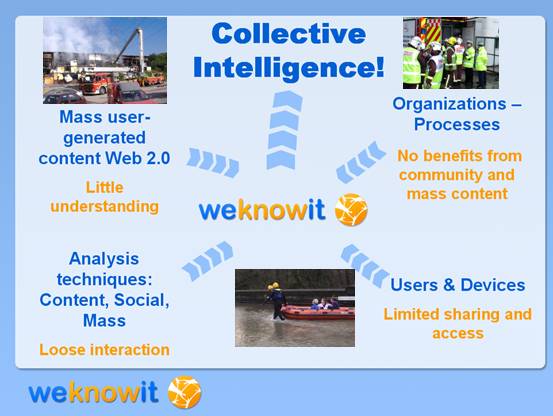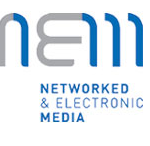Project description
Novel techniques for generating different layers of intelligence
Due to advances in communications, mobile devices and Web technologies, it is nowadays easy for users and organisations to generate and share content, individually or within communities. Yet, current applications do not fully support intelligent processing and management of such information.
The main objective of WeKnowIt is to develop novel techniques for exploiting multiple layers of intelligence from user-contributed content, which together constitute Collective Intelligence, a form of intelligence that emerges from the collaboration and competition among many individuals, and that seemingly has a mind of its own.
To this end, input from various sources is analysed and combined: from digital content items and accompanying metadata (Media Intelligence), massive user feedback (Mass Intelligence), and users social interaction (Social Intelligence) so as to benefit end-users (Personal Intelligence) and organisations (Organisational Intelligence).
WeKnowIt will demonstrate the wide applicability of its achievements through the elaboration on two distinct case studies: an Emergency Response and a Consumers Social Group case study. The two case studies pertain to different topics, target at a wide range of intended users and involve heterogeneous business models so that WeKnowIt achieves the highest possible social impact.
The driving vision behind WeKnowIt is the opportunity to analyse user contributed content by integrating research and development in personalisation, content processing, user feedback, social analysis and knowledge management to automatically generate Collective Intelligence and make it accessible to end users and organisations. Currently Web 2.0 methodologies miss an 'Intelligence' layer over existing manually generated information that would enable the exploitation of the knowledge hidden in the user contributed content. Although current Web 2.0 applications allow and are based on annotations by the users or 'tags', these are not sufficient because user generated tags lack clear semantics, therefore these social annotations are not of much use for web agents and applications. WeKnowIt will not just try to automate the content annotation processing but will also exploit and analyze all available information related to user submitted content by researching novel methods for content processing and analysis, analyse mass user feedback and social interactions. The WeKnowIt approach is built around different Intelligence Layers which address various aspects of user contributed and consumed content. Users submitting content will benefit from the advances of WeKnowIt for bringing Web 2.0 and user contributed content applications to users of mobile devices.

Mass Intelligence combines the information from mass user feedback in order to extract patterns and trends that cannot be extracted by single content items. This adds an additional layer of semantic description to the content or can describe overall situations.
In parallel, Social Intelligence aalyses the usage and communication interaction patterns taking into account the needs and capabilities of communities and provides useful output both for the creation of the Media and Mass as well as for the WeKnowIt applications. For example, the identification of 'authorities' among users can be of benefit for Media and Mass Intelligence creation, since the analysis can place more emphasis on the content of such users. At the same time, WeKnowIt content pushed to 'hub' users ensures faster distribution within communities.
After processing takes places in a continuous interaction way during the creation of Media, Mass and Social Intelligence, the generated Collective Intelligence comprising of all Intelligence Layers is made available to the users through the Personal Intelligence to end users and the Organisational Intelligence to users of organisations. Organisational Intelligence allows support of decision making through workflows exploiting the knowledge generated by WeKnowIt and taking into account existing procedures within the organisation.
The aggregated benefits of Collective Intelligence acquired through the various Intelligence Layers are, in particular, realised by both the end users and the organisations when uploading, searching for, browsing and consuming the content. Realisation of this value comes from an integrated project, where technology development for all parts can be accelerated via the collaboration between the knowledge and multimedia technology domains. Each research activity in WeKnowIt does not only contribute to the generation of Collective Intelligence resulting from each innovation separately, but the integration of these varied activities results in an overall project innovation which exceeds the aggregate of the individual innovation parts.





